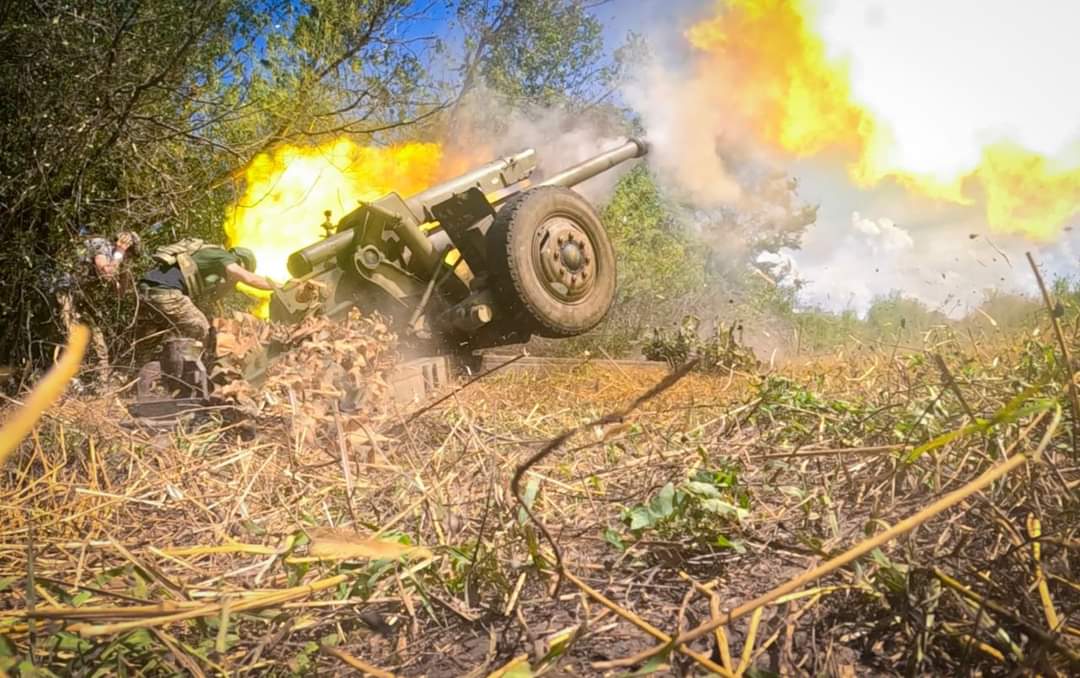Last week was marked by events of strategic importance that could significantly affect the course of the war.
The Ukrainian missile and kamikaze drone strikes against the Russian Black Sea Fleet in occupied Crimea (southern Ukraine) further reduced the combat potential of the Russian Navy.
Ukraine continued its counteroffensive on three different axes in the Zaporizhzhia Oblast on the southern front and in the Donetsk Oblast on the eastern front.
Russia tried to distract Ukrainian forces with attacks near Kupiansk (Kharkiv Oblast, eastern Ukraine), Lyman (Donetsk Oblast, eastern Ukraine), Avdiivka (Donetsk Oblast, eastern Ukraine), and Mariinka (Donetsk Oblast). These are the only areas in Ukraine where the Russian army still goes on the offensive.
Currently, Ukraine has a strategic initiative along almost the entire frontline, stretching over 1,200 kilometers.
Ukrainian breakthrough on the eastern front
The last week began with a swift Ukrainian counterattack in the Avdiivka sector in the Donetsk Oblast, which took Russian troops by surprise in occupied Opytne (south of Avdiivka). On 11 September, the Ukrainians liberated the northern part of the town and consolidated their positions some 13 kilometers north of Donetsk City (occupied by Russia since 2014).
Opytne is located three kilometers northwest of the Donetsk International Airport, which was completely ruined during the heavy fighting in 2014-2015. The Ukrainian advance in this area allows Ukraine’s Armed Forces to strengthen their defense line near Avdiivka, which the Russian Army has been trying to capture since February 2022.

Map by Deep State.
On 15 September, the Ukrainians liberated Andriyivka in the Donetsk Oblast, 13 kilometers southwest of Bakhmut.
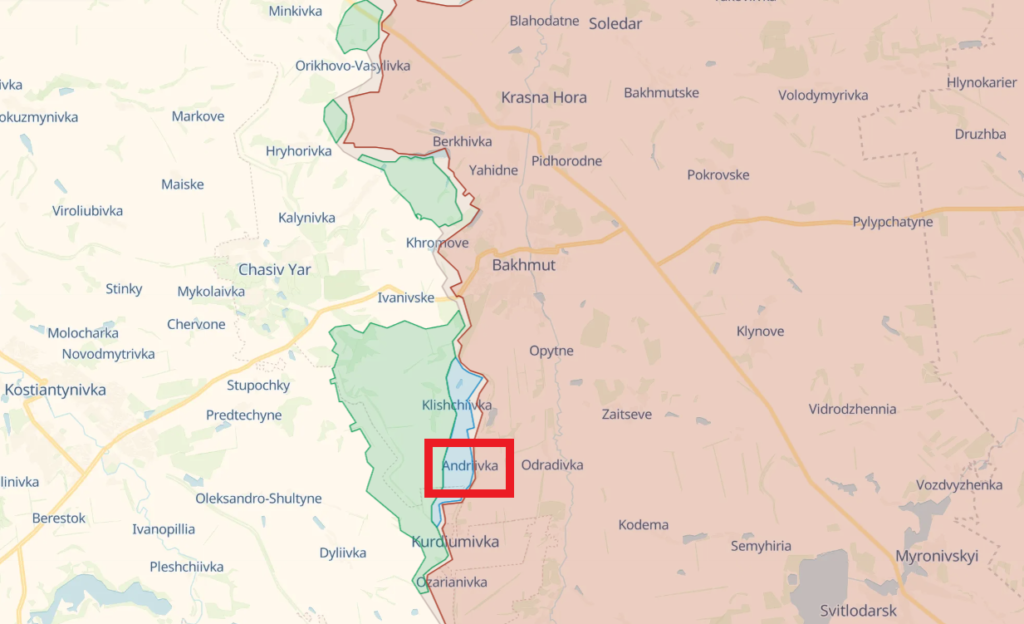
Map by Deep State.
According to the command of the Ukrainian Third Separate Assault Brigade, which liberated Andriyivka, the Russian garrison of this town was surrounded, cut off from the main forces, and destroyed.
https://twitter.com/EuromaidanPress/status/1703001029715833236
On 17 September, Ukraine’s Armed Forces liberated Klishchiyivka in the Donetsk Oblast, the Commander of Ukraine’s Ground Forces, Colonel General Oleksandr Syrskyi reported.

Map by Deep State.
Klishchiyivka is located nine kilometers southwest of Bakhmut. Having pushed Russian troops out of this area, the Ukrainians gained control of the commanding heights, which made it easier for the Ukrainian artillery to target Russian forces in occupied Bakhmut.
https://twitter.com/EuromaidanPress/status/1703455103624036400
Thus, the Ukrainian Army made significant gains on the southern flank of Bakhmut, liberating two towns within one week.
The Russian command threw its best forces into holding Klishchiyivka and Andriyivka, according to the Ukrainian war reporter Yurii Butusov. The flanks of the Russian 72nd Brigade, which defended Andriyivka, were covered by the 85th and 57th Motorized Rifle Brigades and the 31st Air Assault Brigade of the Russian Army. Significant air forces and artillery supported the Russian grouping in Andriyivka and its vicinities.
“However, the Third Assault Brigade of the Armed Forces of Ukraine demonstrated superiority over the Russians in combat capability, organization, and command. It was a victory of quality over quantity. This is how the breakthrough and destruction of the echelon defense nodes of the Russian Armed Forces is achieved,” Butusov wrote on Telegram.
Fierce battles for every meter near Andriyivka and Klishchiyivka were fought for over three months as Ukrainian troops slowly advanced in the Bakhmut sector. Now, the defense line of the Russian forces south of Bakhmut runs along the railroad line.
Ukraine is gradually increasing pressure on the southern and northern flanks around Bakhmut, threatening to encircle the town. While Russian counterattacks north of Bakhmut are helping to slow the advance of Ukrainian troops in that area, Russian defenses south of Bakhmut are close to collapse.
Although Ukrainian counterattacks in the Bakhmut sector are hardly the main effort of the ongoing counteroffensive, they are an essential part of it, pinning a significant number of Russian forces in this area.
According to Ukraine’s Eastern Military Group spox, Illia Yevlash, the Russians have concentrated 52,000 troops, 274 tanks, more than a thousand armored vehicles, 150 artillery systems, and over 120 multiple rocket launchers in the Bakhmut sector. Russia has deployed about 150,000 troops to the eastern front in the Donetsk, Luhansk, and Kharkiv oblasts of Ukraine, Illia Yevlash said.
Despite its little tactical and strategic importance for both sides, Bakhmut became the longest and bloodiest siege of the Russian all-out war against Ukraine. The battle for this emblematic Ukrainian stronghold started in August 2022 and lasted more than nine months before the Russian army captured the town in May 2023. Russia invested a lot of effort and suffered heavy casualties to capture Bakhmut and, therefore, cannot afford to lose it without a fight.
Even though the Russian army is slowly but steadily losing ground in the Bakhmut sector, the Russian command decided to redeploy some of its troops from the southern flank of Bakhmut to the Zaporizhzhia Oblast in southeastern Ukraine, where the main fighting is taking place.
According to the Institute for the Study of War (ISW), the Russian command redeployed the 83rd Assault Brigade from the outskirts of Klishchiyivka to the Zaporizhzhia Oblast on the southern front, which “suggests a deep concern about Ukrainian advances in western Zaporizhzhia Oblast and the Russian prioritization of the defense there.”
Grinding advance of the Ukrainian Army on the southern front
After the liberation of Robotyne in the Zaporizhzhia Oblast on 22 August, the Ukrainian Army broke through the first line of the Russian defense (out of three fortified defensive lines) and continued to advance southward. To reach Robotyne, which Russian forces turned into a heavily fortified stronghold, Ukrainian troops had to get over kilometers of dense Russian minefields.
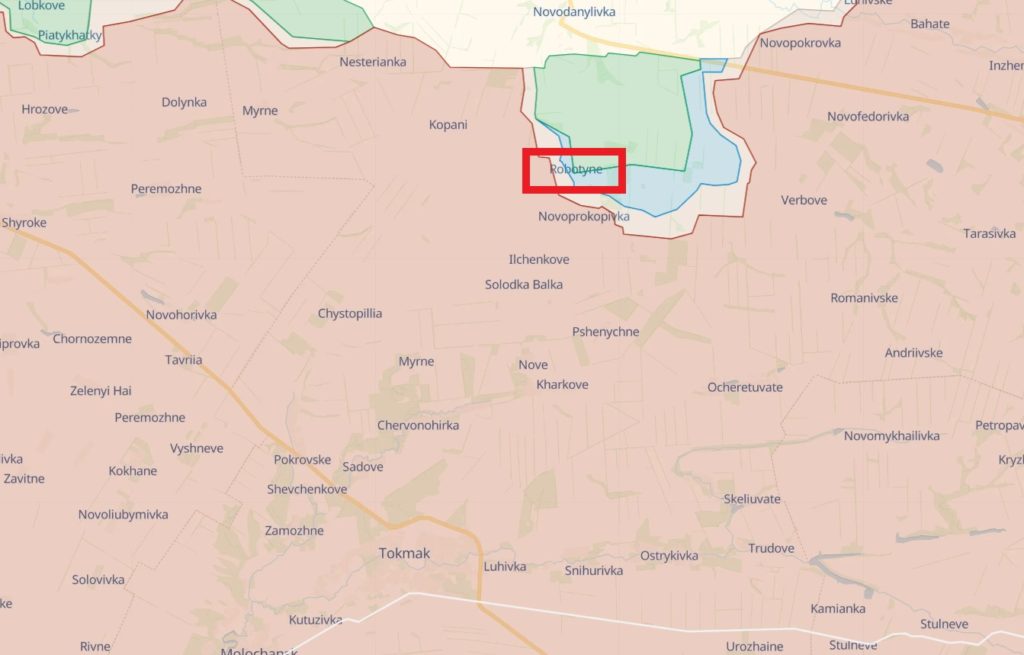
Map by Deep State.
Advancing in this area allows Ukrainian forces to begin operating beyond the densest of the Russian minefields that have held up the counteroffensive all summer long, the ISW reported.
The territory between the first and the second lines of Russian fortifications in the Zaporizhzhia Oblast may not contain such dense minefields as those that Ukrainian troops overcame on the way to Robotyne. The Russians had to leave mine-free areas to be able to move between the first and the second defensive lines.
Ukrainian troops are slowly moving forward south and southeast of Robotyne. The heaviest fighting is now taking place on the northern outskirts of Novoprokopivka (south of Robotyne) and the northwestern outskirts of Verbove (southeast of Robotyne) in the areas where the Russians built their second defensive line.
The Ukrainian Army has already cut off the main road between Novoprokopivka and Verbove, isolating the Russian garrisons in these strongholds from each other. The Ukrainians are pushing forward and widening the area of their control to make it hard for Russian troops to counterattack on the flanks.
The distance between Novoprokopivka and occupied Tokmak, a vital logistics hub of the Russian forces, is around 20 kilometers. If the Ukrainians push Russian troops out of their stronghold in Novoprokopivka and approach the third line of Russian fortified defense, the number of well-prepared reserves on both sides will become one of the key factors in the battle for Tokmak.

Map by Deep State.
Although it is still a long way from Novoprokopivka to Tokmak, the liberation of Novoprokopivka would help Ukrainian tube artillery get closer to vital Russian ground lines of communication and further disrupt Russian logistics, reducing the ability of the Russian Army to repel the Ukrainian offensive.
Thus, the Ukrainian advance to Novoprokopivka is actually the beginning of the battle for Tokmak. Success in the battle of Tokmak would allow the Ukrainian artillery to cut off Russian key supply routes in southern Ukraine and disrupt the so-called land bridge from Russia to occupied Crimea.
The liberation of Crimea, which seemed absolutely impossible just a year ago, depends on whether Ukraine can liberate the Zaporizhzhia Oblast, where the Ukrainian counteroffensive is gaining momentum now.
Before the next offensive phase can begin, Ukraine must degrade Russian heavy equipment, especially the firepower system. The only way to do that is to lure Russian forces into the range of HIMARS strikes and precision-guided artillery shells by attacking the Russian defensive lines, which is exactly what the Ukrainian Army is doing.
According to the Ukrainian General Staff, the losses of Russian self-propelled and towed artillery have soared dramatically in the summer of 2023. Ukrainian forces destroy dozens of Russian artillery systems every day (based on data published by Ukraine’s General Staff in its daily updates).
Oryx, a Dutch open-source intelligence monitoring group that documents Ukrainian and Russian military equipment losses based on photo and videographic evidence, confirms that Russian artillery losses have increased during the Ukrainian counteroffensive in June, July, and August 2023 compared to previous months of Russia’s invasion.
According to Ukraine’s General Staff, in September, the Russian Army lost 473 artillery systems (with the average monthly loss of Russian artillery systems being 300 units). Last week alone, Russia lost 164 artillery systems (with the average weekly loss of Russian artillery systems being 73 units).
Besides targeting Russian military equipment, Ukraine actively uses Western newly supplied cluster munitions to eliminate Russian manpower entrenched in multilayered defensive lines.
The United States gave Ukraine an unknown amount of dual-purpose improved conventional munitions (DPICM) to strike at Russian infantry and armor. A DPICM is an artillery or surface-to-surface missile warhead designed to burst into submunitions at an optimum altitude and distance from the desired target for dense area coverage.
According to Def Mon, an OSINT analyst, the Russian Army keeps counter-attacking the advancing Ukrainian forces instead of falling back to the prepared defensive lines, which, along with the effective use of DPICM cluster munitions, leads to high attrition of the Russian Army on the southern front.
Russia has deployed more than 420,000 troops in the occupied territories of Ukraine, Ukraine’s intelligence deputy head, Vadym Skybytskyi, said during the Yalta European Strategy (YES) annual summit in Kyiv last week.
According to Ukraine’s intelligence, the Russian forces use the following military equipment during the ongoing invasion of Ukraine:
- 2,260 tanks
- 5,260 armored combat vehicles
- 3,050 artillery systems
- 920 multiple rocket launchers
- 360 airplanes
- 320 helicopters
- 64 ships/boats
- 5 submarines
Last week, the Ukrainian missile and kamikaze drone attacks on Russian naval vessels caused significant damage to Russia’s Black Sea Fleet.
Ukrainian attacks on Russian military targets in occupied Crimea and the Black Sea
On 11 September, Ukraine regained control of four oil and gas drilling platforms off the coast of Crimea in the Black Sea, namely the Petro Hodovalets, Ukraine, Tavryda, and Syvash oil and gas rigs.
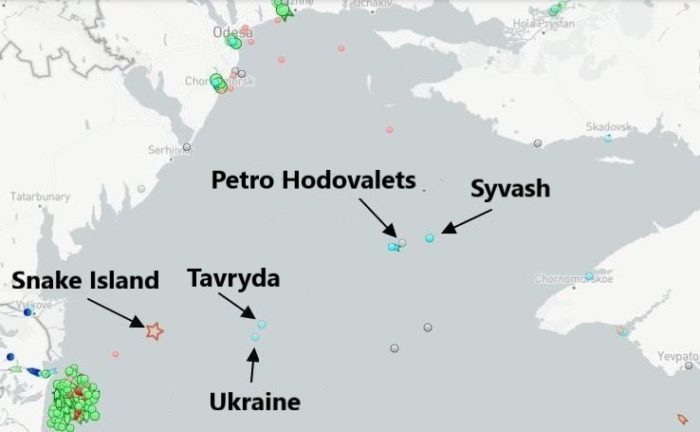
Credit: Roman Shrike.
Russia occupied these drilling platforms in 2015 and used them for military purposes since the beginning of the full-scale invasion of Ukraine in February 2022. The Russians used the rigs as helicopter landing sites and to deploy radar equipment.

The Ukrainian Special Operations Forces seized valuable trophies at the drilling platforms: a stockpile of helicopter munitions (unguided aircraft missiles) and the Russian Neva radar, which can track the movement of ships in the Black Sea, Ukraine’s intelligence reported.
According to British intelligence, the drilling platforms and Zmiinyi (Snake) Island serve as “forward deployment bases, helipads, and potential sites for long-range missile systems.” Thus, Russia’s loss of control over the drilling platforms facilitated Ukrainian maritime drone attacks on the Russian Black Sea Fleet in occupied Crimea (southern Ukraine), making it harder for Russia to blockade Ukrainian Black Sea ports.
On 13 September, Ukrainian missiles struck dry docks at the Sevastopol naval base of the Russian Black Sea Fleet in occupied Crimea. Open-source evidence (photos, satellite images, and a video) indicated the Ukrainian attack most likely destroyed a Ropucha-class landing ship, Minsk, and severely damaged a KILO-class submarine, Rostov-on-Don. The warship and submarine were hit while undergoing maintenance in the dry docks.

Ukraine’s Air Force Commander Mykola Oleshchuk hinted in a social media post that the night attack on Sevastopol was carried out by Ukrainian aircraft capable of launching British Storm Shadow cruise missiles.
According to Mykhailo Zhyrokhov, a Ukrainian military expert, Ukraine most likely used a combination of different missiles to attack the Sevastopol dry docks: HARM missiles against Russian air defense radars, followed by Storm Shadow missiles against the ship and submarine. This is the first time in history that a cruise missile has destroyed a submarine.
Ukraine's special ops landed in Crimea to guide missile strike on Russian warships
In a unique operation, Ukraine's Special Operation Forces landed in occupied Crimea to direct a high-precision missile strike on a Russian landing ship and submarine in Sevastopol… pic.twitter.com/gTxs8cGfJo
— Euromaidan Press (@EuromaidanPress) September 16, 2023
The Ukrainian missile attack most likely damaged the Rostov-on-Don submarine beyond repair. According to Ukrainian military expert Oleksandr Kovalenko, the Rostov-on-Don submarine suffered significant damage to its bow. It will take three to four years to repair the submarine, and the repair cost will almost equal the cost of producing a new submarine. Thus, its repair makes little sense, according to Oleksandr Kovalenko. The Rostov-on-Don submarine had four missile launchers for 24 Kalibr cruise missiles.
According to the Dutch open-source intelligence warfare research group Oryx, visual confirmation indicates that the Russian Ropucha-class landing ship Minsk was destroyed by the Ukrainian missile attack on 13 September, not merely damaged. Judging by the photo of the Russian warship Minsk after the Ukrainian missile attack, it is clear that everything above the ship’s deck burned out.

Credit: Krymskiy Veter via Telegram.
Apart from amphibious assault operations, Russia uses Ropucha-class landing ships to transport ammunition and military equipment from the territory of Russia to the occupied territories of Ukraine in Crimea and Zaporizhzhia Oblast.
A Ropucha-class warship, such as the Minsk landing ship, can carry 450 tons of cargo. The loss of this ship is a heavy blow to Russian logistical capabilities, especially in case anything happens to the Kerch Bridge (also known as the Crimean Bridge), the critical supply route linking Russia to occupied Crimea.

Map by Deep State.
To supply its troops in southern Ukraine, Russia can only use the railway from the Krasnodar region in southwestern Russia that leads to southern Ukraine via the Kerch Bridge in occupied Crimea through the Chonhar Bridge in the Kherson Oblast and via Armiansk in the northern part of Crimea (the railroad through Armiansk is going to Kherson, which is under Ukrainian control). Another option to supply Russian troops on the occupied territories of southern Ukraine is to use the railroads from Russia to the occupied Luhansk and Donetsk Oblasts.
The only problem with this route is that it is cut off by the Ukrainian artillery fire in Volnovakha (Donetsk Oblast). No trains can go through this area down south to the Zaporizhzhia Oblast.
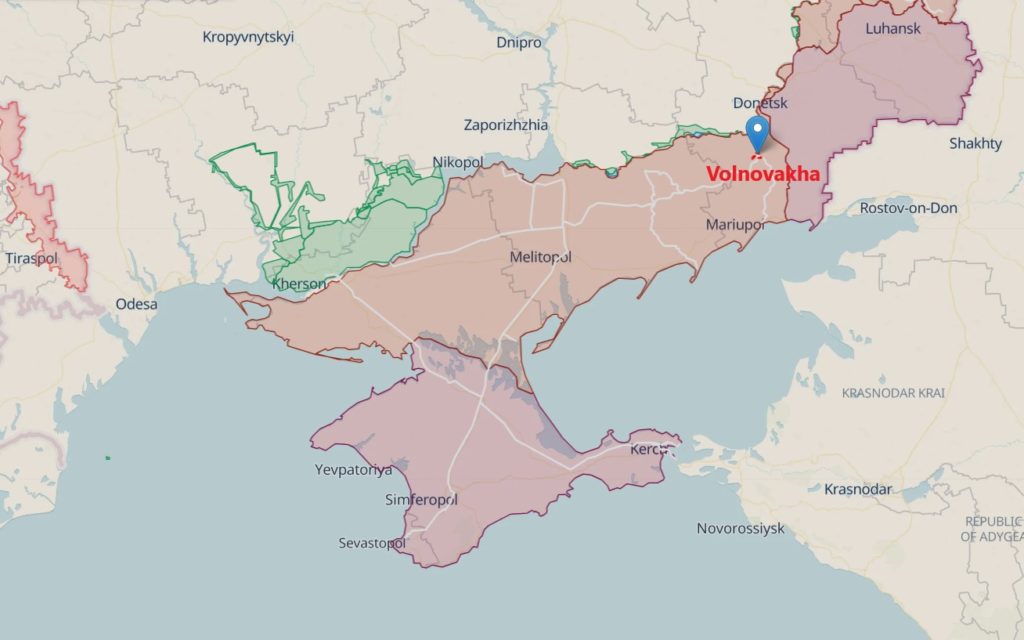
Map by Deep State.
On 14 September, Ukrainian maritime kamikaze drones attacked Samum hovercraft of the Russian Black Sea Fleet, the Russian Defense Ministry reported.
According to Russia’s Defense Ministry, the Ukrainian drones attacked Samum hovercraft in the Black Sea around 4:30 p.m. The Russian Defense Ministry claimed the ship’s weapons destroyed all maritime kamikaze drones.
However, despite Russian claims, the Ukrainian attack most likely damaged Samum hovercraft. A photo of tugboats towing the leaning Samum ship was shared online on 16 September.

The strike was made with the experimental naval drone Sea Baby, designed to operate in stormy conditions and evade detection behind high waves. Russia claimed it repelled the attack. Photo: SBU
Samum is a Bora-class guided-missile corvette of the Russian Navy (Soviet designation Project 1239), one of the few types of military surface effect ships built solely for marine combat. It is one of Russia’s largest combat sea vehicles with a catamaran design. A ship supposed to destroy maritime drones and targets alike was struck by a Ukrainian experimental maritime kamikaze drone, Sea Baby, designed to operate in stormy conditions and evade detection behind high waves, according to Ukraine’s Security Service (SBU).
In addition to Samum ship, on 15 September, the Russian frigate Admiral Makarov also returned to the harbor of occupied Sevastopol with the help of tugboats, as evidenced by a satellite image provided by Planet.com. The Russian Defense Ministry reported that all attacks by Ukrainian naval drones on the aforementioned ships were successfully repelled.

Satellite image by Planet.com
In just four days, Ukraine attacked at least seven Russian naval vessels in the Black Sea with missiles and drones, destroying Tunets (Tuna) boat and Minsk landing ship and damaging the Rostov-on-Don submarine and two Kalibr-NK missile-carrying patrol boats (of the same class as the patrol ship Vasily Bykov of Project 22160), the Strategic Communications Department of Ukraine’s Armed Forces reported.
Following the loss of several naval vessels to Ukrainian strikes within just one week, the Russians have relocated three large landing ships from the Black Sea to the Sea of Azov, spokesman of the Ukrainian Naval Forces, Dmytro Pletenchuk, said during the Ukrainian telethon. Thus, Russia’s $30 billion Black Sea Fleet is working hard to avoid Ukraine’s cheap but dangerous unmanned naval siege.
Apart from Russian warships, Ukraine’s Armed Forces also hunted for Russian air defense systems last week. Ukraine used a combination of aerial kamikaze drones and Ukrainian-made Neptune cruise missiles to target the best Russian air defense system (S-400 Triumf) near Yevpatoria in occupied Crimea early in the morning on 14 September, according to Ukraine’s Security Service (SBU). The satellite image published by Radio Svoboda showed that Ukraine may have destroyed a launcher and radar of the S-400 Triumf surface-to-air missile complex.
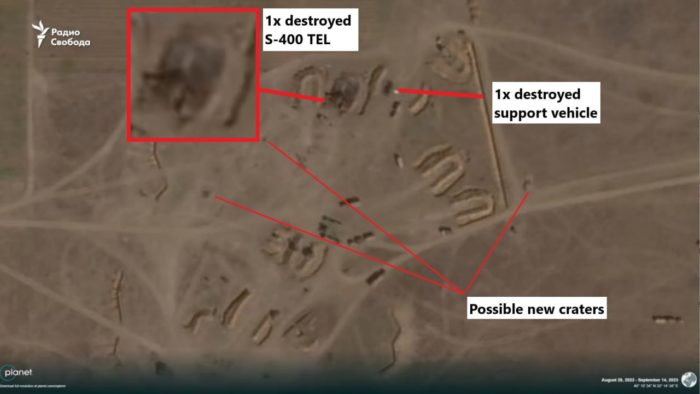
Credit: Radio Svoboda.
This is not the first time Ukraine has struck Russian air defense systems in the western part of occupied Crimea. On 23 August, the Ukrainian Army destroyed a Russian S-400 Triumf air defense system on Cape Tarkhankut in Crimea.
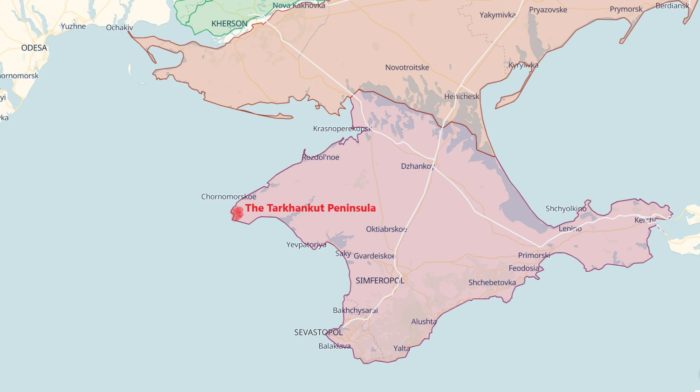
Map by Deep State.
According to Ukraine’s intelligence, the attacks on the Russian air defense systems in western Crimea degraded Russian air defense capabilities. Such attacks hamper the Russian ability to monitor its airspace and protect military bases in occupied Crimea.
Related:
- Ukrainian counteroffensive: genocide of Russian artillery
- Forbes: Russia spends USD 300 million a day on war against Ukraine
- How Ukraine’s scrappy marine drones are revolutionizing naval warfare

